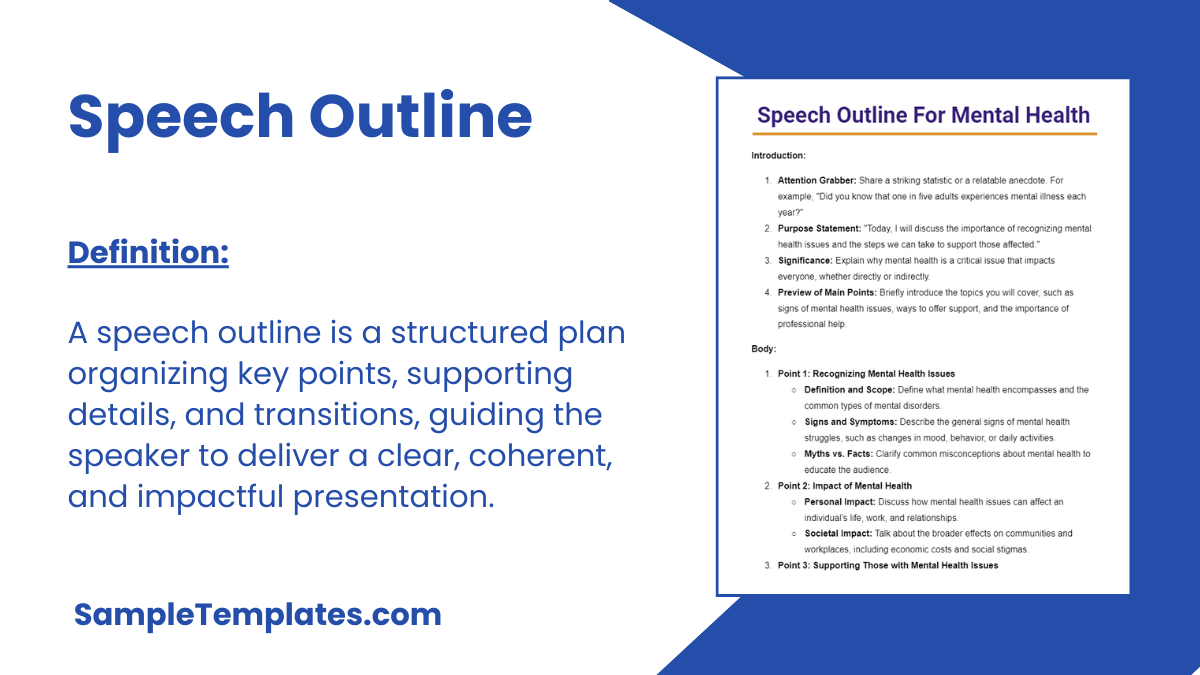Speech outlining is the second step after speech topic selection during speech preparation. It is also called as a speech blueprint. It is a process of plotting and mapping a script to hold and engage the audience. Speech outline contains various elements for plotting effective presentation and speeches. Let us explore the sample speech outline examples by downloading the below documents. Get persuasive speech examples, Graduation speech examples, and speech presentation outline examples to outline custom speeches.
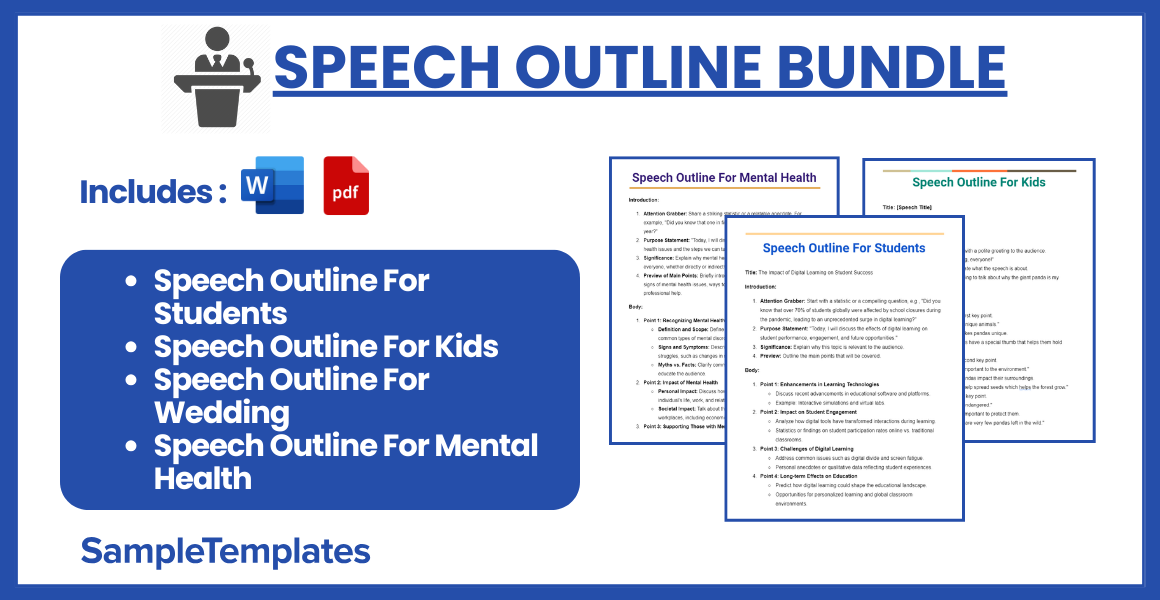
Download Speech Outline Bundle
Speech Outline For Students
Title: The Impact of Digital Learning on Student Success
Introduction:
- Attention Grabber: Start with a statistic or a compelling question, e.g., “Did you know that over 70% of students globally were affected by school closures during the pandemic, leading to an unprecedented surge in digital learning?”
- Purpose Statement: “Today, I will discuss the effects of digital learning on student performance, engagement, and future opportunities.”
- Significance: Explain why this topic is relevant to the audience.
- Preview: Outline the main points that will be covered.
Body:
- Point 1: Enhancements in Learning Technologies
- Discuss recent advancements in educational software and platforms.
- Example: Interactive simulations and virtual labs.
- Point 2: Impact on Student Engagement
- Analyze how digital tools have transformed interactions during learning.
- Statistics or findings on student participation rates online vs. traditional classrooms.
- Point 3: Challenges of Digital Learning
- Address common issues such as digital divide and screen fatigue.
- Personal anecdotes or qualitative data reflecting student experiences.
- Point 4: Long-term Effects on Education
- Predict how digital learning could shape the educational landscape.
- Opportunities for personalized learning and global classroom environments.
Conclusion:
- Summary of Main Points: Recap the impacts and challenges discussed.
- Restatement of the Purpose: Reaffirm the significance of adapting to digital learning.
- Closing Thought: Leave the audience with a thought-provoking statement or a call to action, such as encouraging peers to leverage digital tools for learning.
Q&A:
- Open the floor for questions to engage with the audience further.
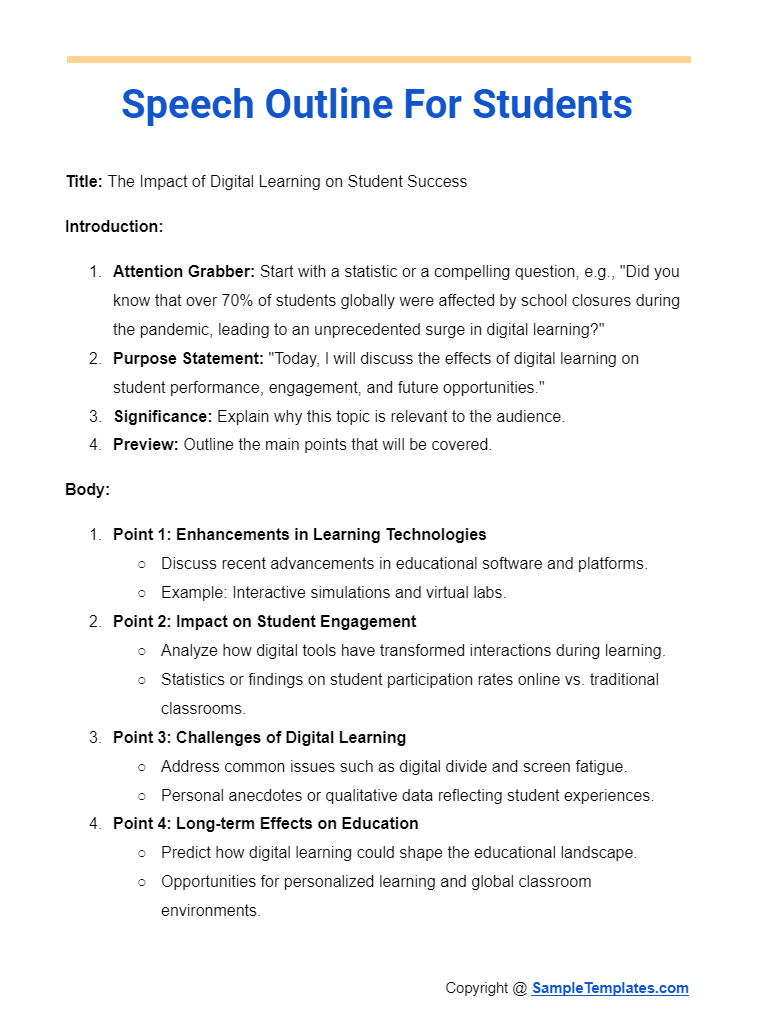
Speech Outline For Kids
Title: [Speech Title]
Example: “My Favorite Animal”
Introduction:
- Greeting: Teach them to start with a polite greeting to the audience.
- Example: “Good morning, everyone!”
- Topic Introduction: Clearly state what the speech is about.
- Example: “Today, I’m going to talk about why the giant panda is my favorite animal.”
Body:
- Main Point #1: Introduce the first key point.
- Example: “Pandas are unique animals.”
- Detail: Explain what makes pandas unique.
- Example: “Pandas have a special thumb that helps them hold bamboo.”
- Main Point #2: Discuss the second key point.
- Example: “Pandas are important to the environment.”
- Detail: Describe how pandas impact their surroundings.
- Example: “They help spread seeds which helps the forest grow.”
- Main Point #3: Cover the third key point.
- Example: “Pandas are endangered.”
- Detail: Explain why it’s important to protect them.
- Example: “There are very few pandas left in the wild.”
Conclusion:
- Summary: Recap the main points briefly.
- Example: “So, pandas are not only unique and important to the environment, but they also need our help.”
- Closing Message: End with a memorable closing line or call to action.
- Example: “Let’s all learn more about how we can help save the pandas!”
- Thank You: Remind them to thank their audience.
- Example: “Thank you for listening to my speech about pandas!”
Tips for Kids:
- Practice: Encourage them to practice their speech multiple times.
- Visual Aids: Use pictures or props to make the speech more interesting.
- Speak Slowly: Teach them to speak slowly and clearly to make sure everyone understands.
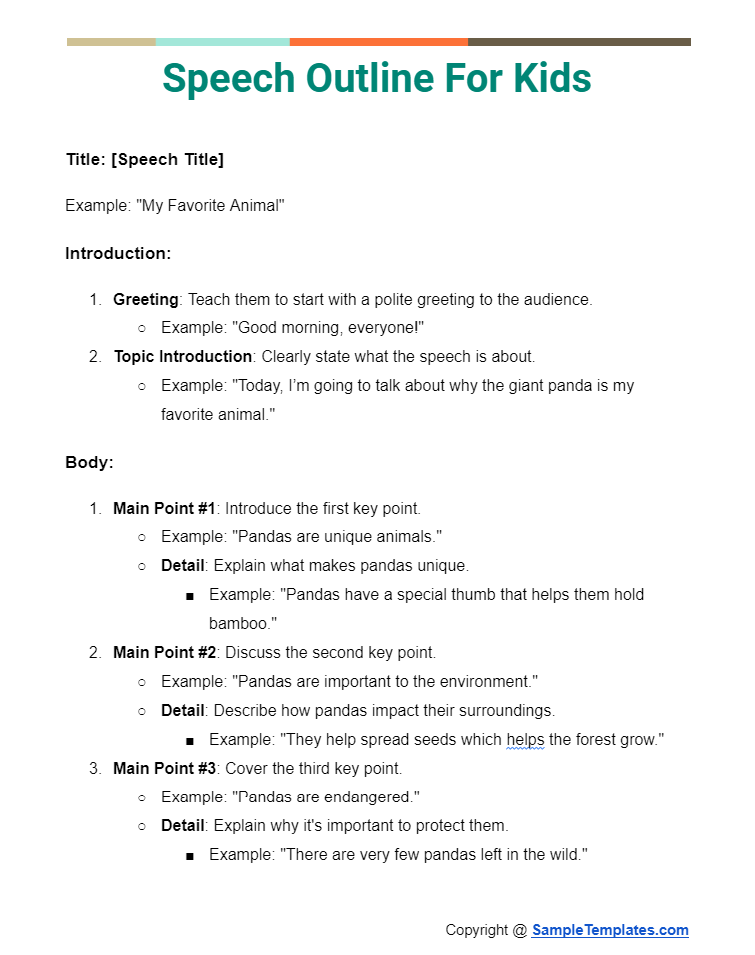
Speech Outline For Wedding
Title: Toast to the Newlyweds
Introduction:
- Greetings and Acknowledgements:
- Begin by introducing yourself and your relationship to the couple.
- Acknowledge important guests and family members, thanking them for coming.
- Expression of Gratitude:
- Thank the couple for the honor of being part of their special day.
- Mention the beauty of the ceremony and the venue.
Body:
- Storytelling:
- Share a personal story or anecdote about your relationship with the bride, groom, or both. Choose a story that highlights their personalities or their relationship dynamics.
- Make sure the story is appropriate, heartwarming, and adds personal insight or humor.
- Qualities and Praise:
- Speak about the qualities that make each individual special and what they bring to their relationship.
- Examples could include anecdotes demonstrating the bride’s kindness, the groom’s loyalty, or their mutual passions and goals.
- Relationship Highlights:
- Reflect on the journey of the couple’s relationship that you’ve witnessed.
- Mention milestones or challenges they’ve overcome together, emphasizing their strength as a team.
Conclusion:
- Well Wishes:
- Offer your best wishes for their future, highlighting hopes for happiness, prosperity, and lasting love.
- Include a quote or a piece of advice about marriage that resonates with the couple’s relationship.
- Toast:
- Invite all guests to raise a glass in honor of the couple’s new journey.
- End with a heartfelt toast, such as “To love, laughter, and happily ever after!”

Speech Outline For Mental Health
Introduction:
- Attention Grabber: Share a striking statistic or a relatable anecdote. For example, “Did you know that one in five adults experiences mental illness each year?”
- Purpose Statement: “Today, I will discuss the importance of recognizing mental health issues and the steps we can take to support those affected.”
- Significance: Explain why mental health is a critical issue that impacts everyone, whether directly or indirectly.
- Preview of Main Points: Briefly introduce the topics you will cover, such as signs of mental health issues, ways to offer support, and the importance of professional help.
Body:
- Point 1: Recognizing Mental Health Issues
- Definition and Scope: Define what mental health encompasses and the common types of mental disorders.
- Signs and Symptoms: Describe the general signs of mental health struggles, such as changes in mood, behavior, or daily activities.
- Myths vs. Facts: Clarify common misconceptions about mental health to educate the audience.
- Point 2: Impact of Mental Health
- Personal Impact: Discuss how mental health issues can affect an individual’s life, work, and relationships.
- Societal Impact: Talk about the broader effects on communities and workplaces, including economic costs and social stigmas.
- Point 3: Supporting Those with Mental Health Issues
- How to Offer Help: Provide tips on supportive communication, respecting boundaries, and encouraging professional help.
- Resources Available: Highlight local and national resources, like counseling centers, hotlines, and online support.
- Point 4: Importance of Self-Care and Professional Help
- Self-Care Strategies: Discuss the importance of self-care for everyone, including those helping others with mental health issues.
- Seeking Professional Help: Emphasize the value of professional advice and treatment, debunking any stigma about seeking therapy or medication.
Conclusion:
- Recap of Main Points: Summarize the key points discussed about recognizing, understanding, and supporting mental health.
- Call to Action: Encourage the audience to be proactive in their communities and personal lives, whether by educating themselves further, reaching out to those in need, or advocating for better mental health resources.
- Closing Quote or Statement: Leave the audience with a thought-provoking quote or a hopeful statement about the progress in mental health awareness and support.
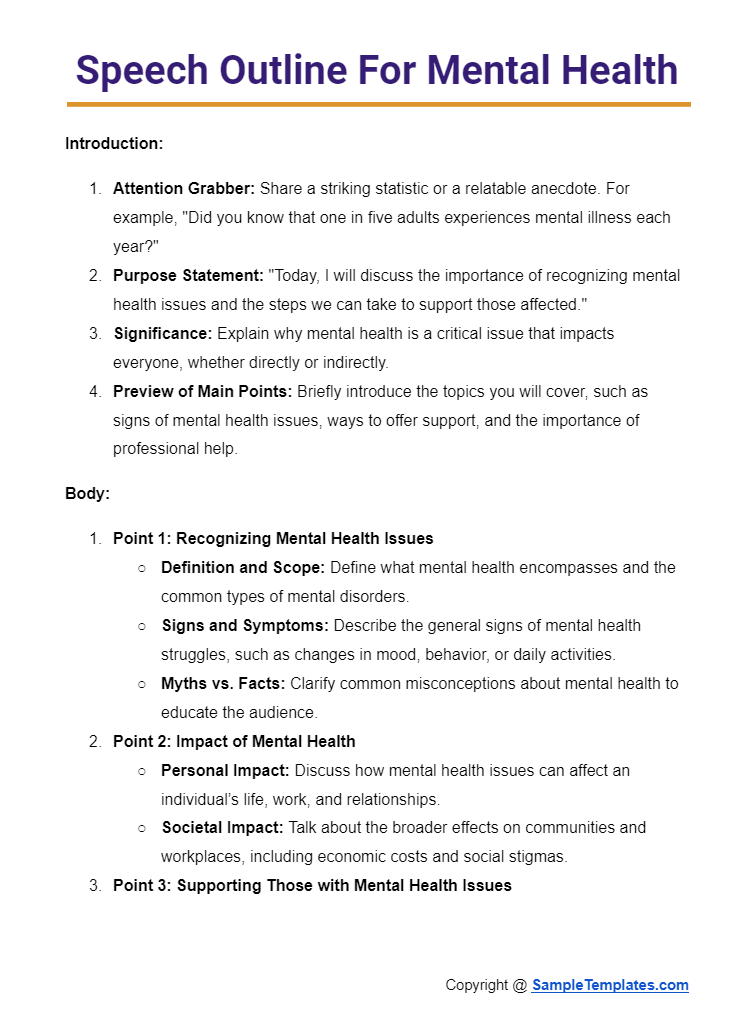
Browse More Templates On Speech Outline
Informative Speech Outline Example
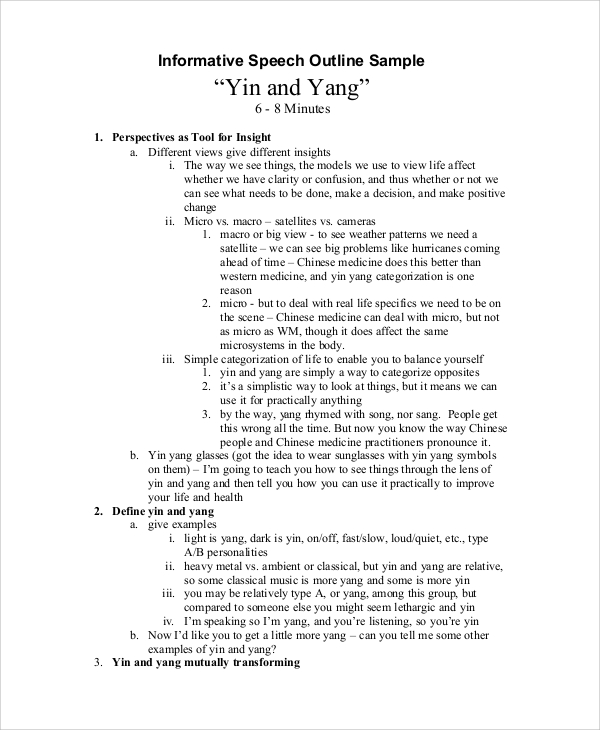
Details
File Format
Size: 147 KB
DownloadDownload the PDF and check informative speech outline example document. Read the sample outline script and get ideas to explore and define your topic. Prepare a 6-8 minute informative speech script for bringing engagement and appreciation.
Persuasive Speech Outline Example
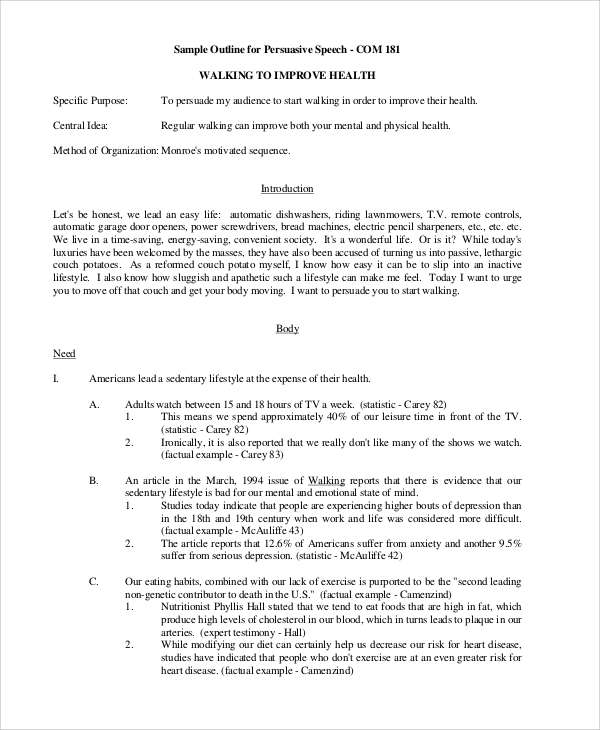
Details
File Format
Size: 22 KB
DownloadPersuasive speeches are written to motivate or convince the audience. Download the Persuasive speech outline Example PDF and get help in outlining your speech.
Purpose of Speech Outline
- Structure and Organization: It provides a clear structure for your speech, organizing your thoughts and main points in a logical sequence to ensure cohesive flow and clarity. You can also see more on Speech Formats.
- Time Management: An outline helps you manage your speaking time more effectively, ensuring that you cover all necessary points within the allotted time without rushing or running over.
- Focus on Key Points: By mapping out your main ideas beforehand, the outline keeps you focused on the most important points, reducing the risk of going off-topic during the speech.
- Enhances Memory: An outline serves as a mnemonic device, helping you remember the sequence of points and details to be covered, reducing the need for extensive notes or scripts.
- Facilitates Practice: With a structured outline, you can practice your speech more efficiently, focusing on transitions, timing, and the delivery of key messages. You can also see more on Speech Examples.
- Reduces Anxiety: Knowing that you have a well-prepared structure to follow can reduce anxiety and boost confidence when speaking in front of an audience.
- Improves Persuasiveness: An outline helps you strategically place arguments and persuasive points where they will have the most impact, enhancing the persuasive quality of your speech.
- Allows Flexibility: While providing structure, a good outline also allows for flexibility during delivery, enabling you to adapt based on audience reactions and feedback, or to emphasize points that resonate more during the actual presentation. You can also see more on Informative Speech.
Introduction Speech Outline Example

Details
File Format
Size: 2 MB
DownloadIntroduction speech is used to introduce guests. It should be a welcoming, attentive, and motivating to gather audience attention. Download Introduction speech outline example PDF guide and get a brief note on writing effective introduction speech along with examples.
Speech Presentation Outline Example
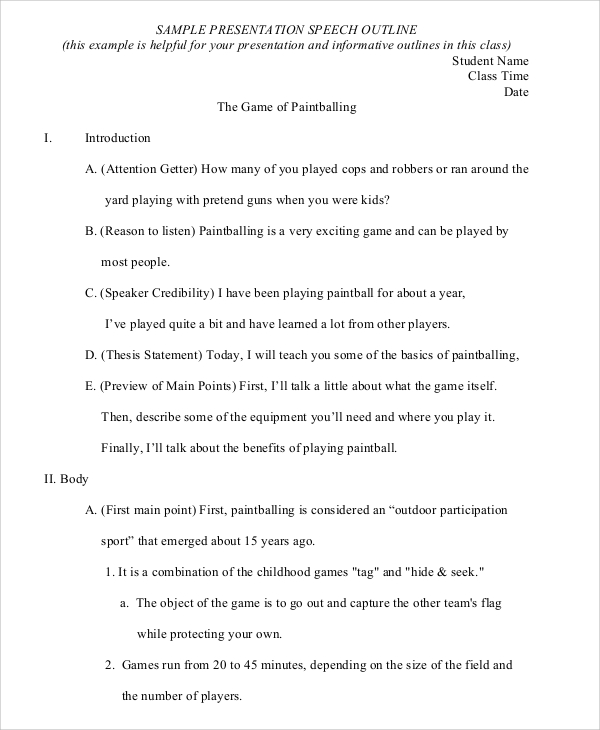
Details
File Format
Size: 92 KB
DownloadHow to Write a Speech Outline?
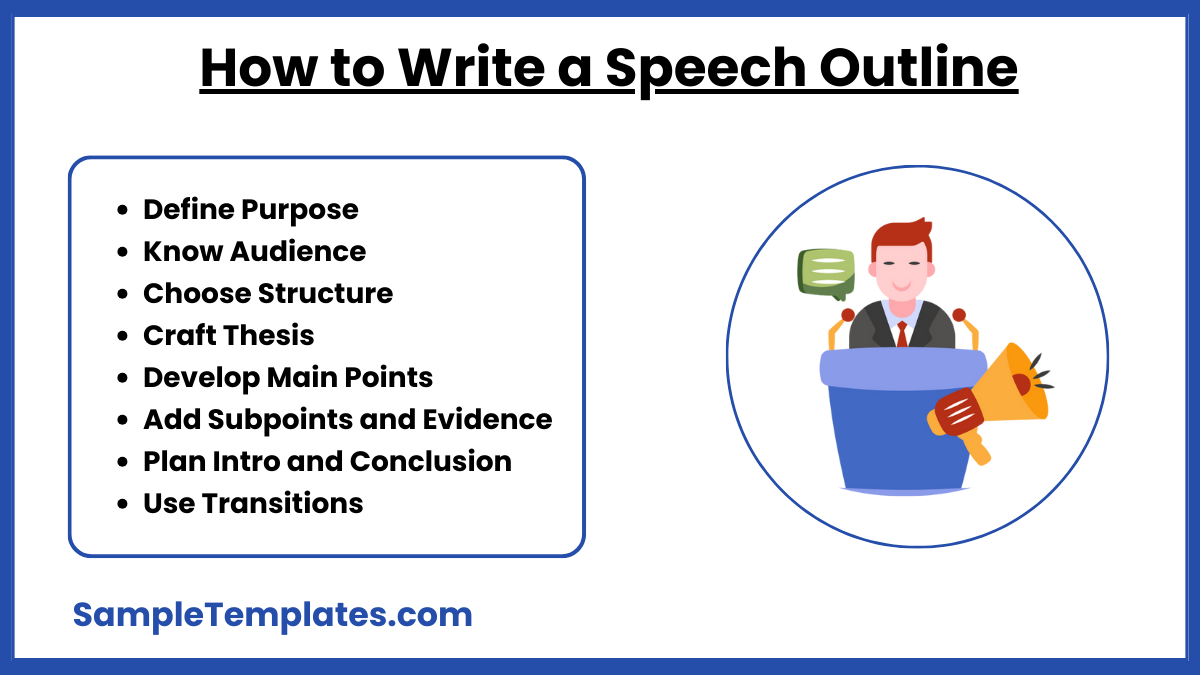
- Define Your Purpose: Start by clearly defining the purpose of your speech. Are you informing, persuading, entertaining, or motivating your audience? This will guide the direction of your content. You can also see more on Speech Writing.
- Know Your Audience: Understand who your audience is, their level of knowledge about the topic, their interests, and what they are hoping to gain from your speech. This will help tailor your message effectively.
- Choose a Structure: Decide on the structure of your speech. Common formats include chronological, spatial, problem-solution, cause-effect, and topical. The structure should support the purpose and make it easier for the audience to follow.
- Craft Your Thesis Statement: Develop a clear thesis statement that encapsulates the main message or argument of your speech. This will keep your presentation focused. You can also see more on Demonstrative Speech Outline.
- Develop Main Points: Identify the main points that will support your thesis. Limit these to a few to avoid overwhelming your audience and to allow adequate time to elaborate on each one.
- Support with Subpoints and Evidence: For each main point, add subpoints and supporting evidence, such as statistics, quotes, examples, and personal anecdotes. This depth adds credibility and interest to your speech.
- Plan Your Introduction and Conclusion:
- Introduction: Start with a hook to grab attention, introduce your topic and thesis, and outline what you will cover.
- Conclusion: Summarize the main points, restate your thesis in light of the evidence presented, and end with a call to action or closing thought.
- Incorporate Transitions: Plan transitions between points to maintain a smooth flow. Transitions help signal shifts in focus from one main point to another and keep the audience engaged. You can also see more on Presentation Outline.
Speech Preparation Outline Example
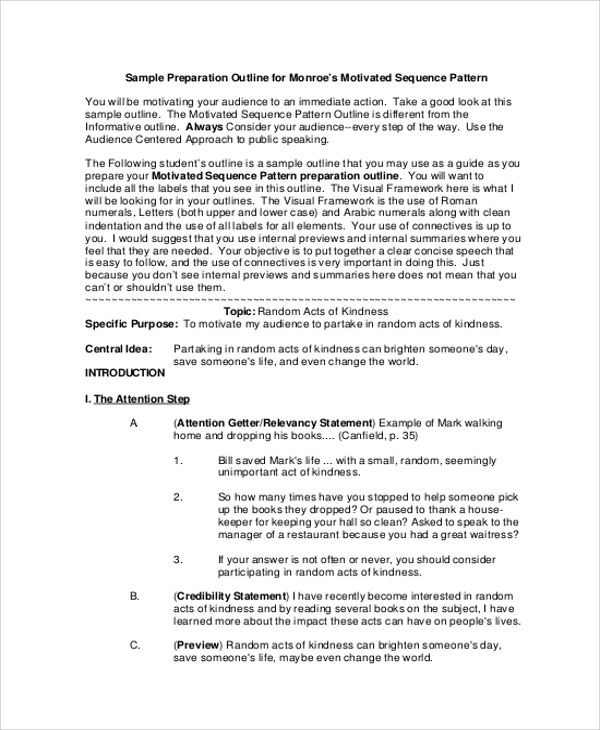
Details
File Format
Size: 9 KB
DownloadSelf Introduction Speech Outline Example
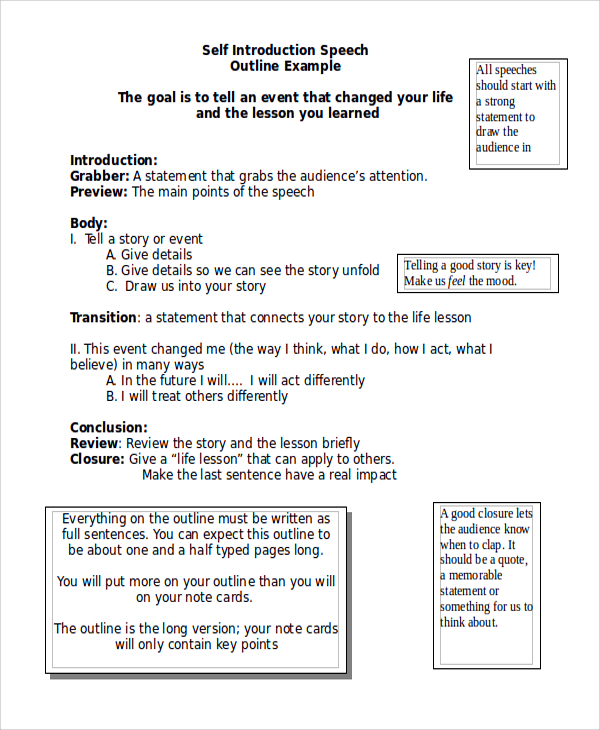
Details
File Format
- DOCX
Size: 6 KB
DownloadBenefits of Speech Outline
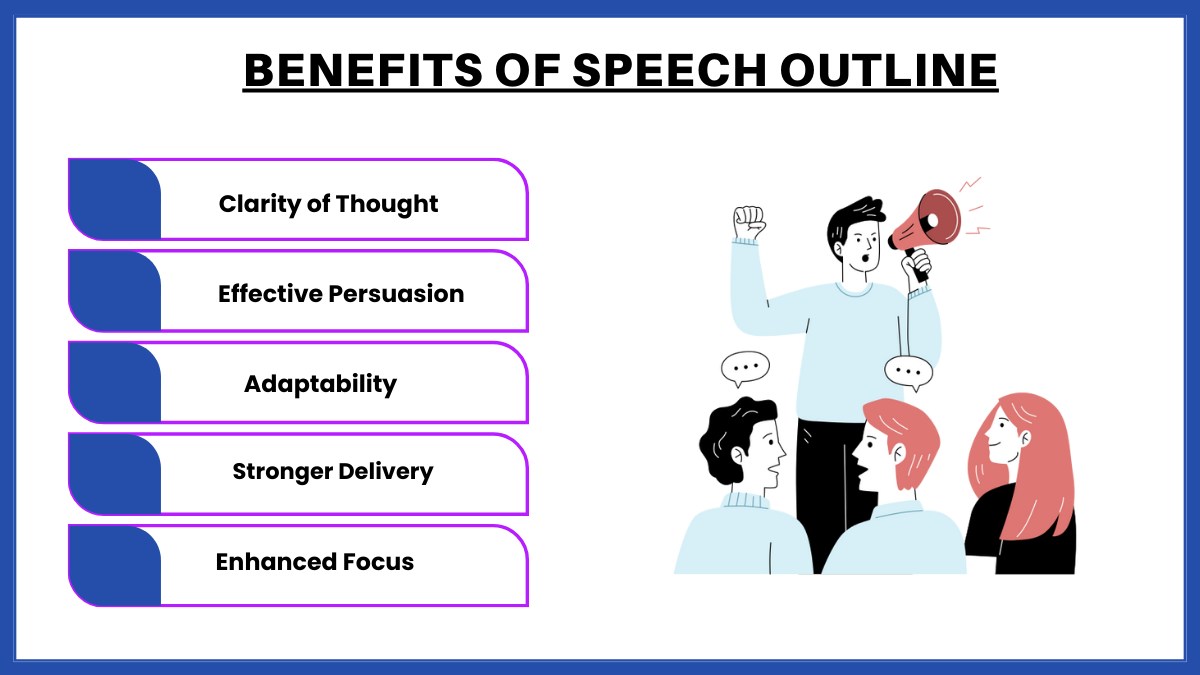
- Clarity of Thought: An outline helps you organize your ideas systematically, promoting clearer thinking and ensuring that all key points are well articulated and logically structured. You can also see more on Introductory Speech.
- Efficient Preparation: With a structured outline, you can streamline the preparation process, saving time and effort as you have a clear plan to follow when researching and writing your speech.
- Enhanced Focus: A speech outline keeps you focused on your main objectives and prevents you from straying off topic, ensuring that every part of your speech directly supports your primary message.
- Better Time Management: An outline allows you to allocate time to each section of your speech, helping you stay within the given timeframe and cover all important points without rushing or running overtime.
- Stronger Delivery: Knowing the structure of your speech in advance makes it easier to practice and deliver it with confidence, reducing the need for extensive notes and minimizing speaking anxiety. You can also see more on Persuasive Speech Outline.
- Audience Engagement: A well-organized speech that flows logically from one point to the next holds the audience’s attention better and makes the content more digestible and engaging.
- Adaptability: An outline provides a flexible framework that can be adjusted based on audience feedback or time constraints, allowing you to emphasize certain points or skip others as needed during the presentation.
- Effective Persuasion: By strategically organizing your arguments and supporting data, an outline enhances the persuasive impact of your speech, helping you effectively convince or motivate your audience. You can also see more on Informative Speech.
Expository Speech Outline Example
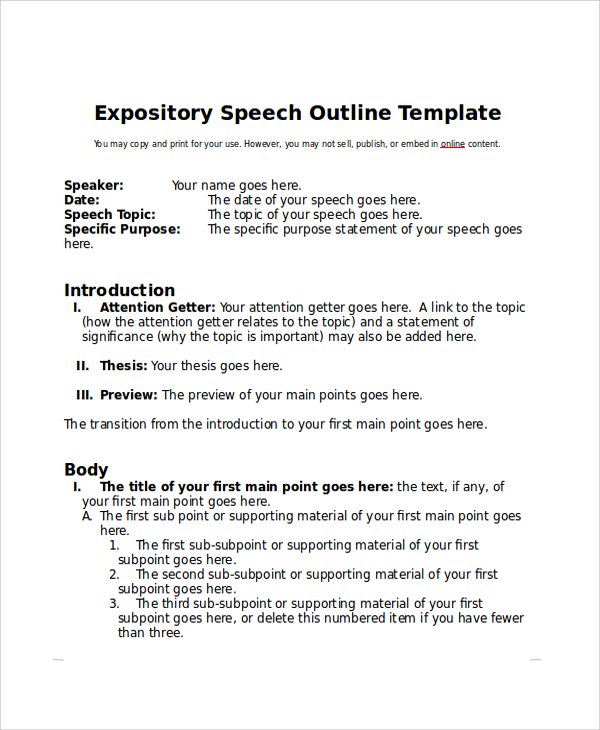
Details
File Format
- DOCX
Size: 17 KB
DownloadDemonstration Speech Outline Example
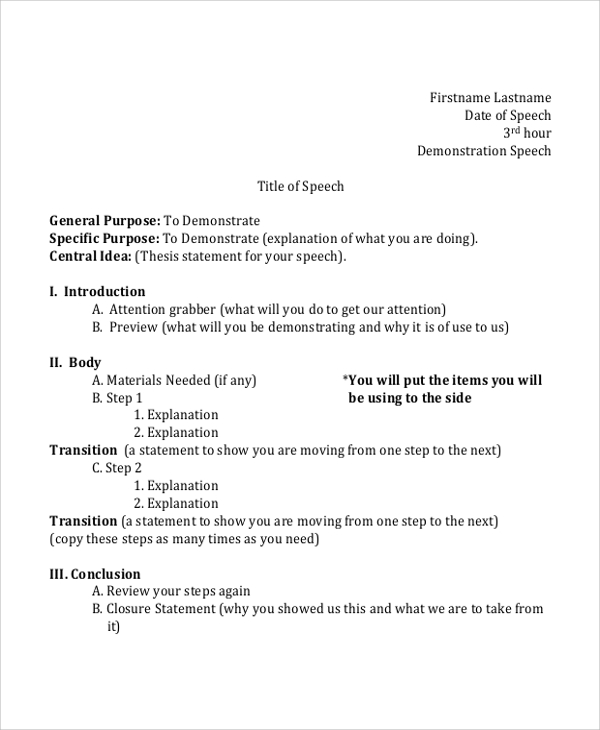
Details
File Format
Size: 32 KB
DownloadTarget Audience
Anyone planning to write informative, persuasive, or any other speech script can use the above sample speech outline examples. These sample of examples will clear your ideas of writing an effective speech and how to present it for driving great engagement. Also, the examples will throw light on speech outline elements, read and utilize them while writing a custom speech outline.
Hope our sample examples have helped you a lot. Outline your speech topic, present it, and receive appreciation from the audience. Also, download our informative speech examples and learn effective informative speech writing. You can also see Commemorative Speech Samples.
How do I start my speech?
Begin with a powerful hook, such as a question, quote, or interesting fact, to capture the audience’s attention. Introduce your main topic clearly and establish your connection to the subject or audience. You can also see more on Self-Introduction Speech.
What are the 3 main parts of a speech outline?
The three main parts of a speech outline are the introduction (grab attention and state the topic), the body (present key points with supporting evidence), and the conclusion (summarize and provide a strong closing statement). You can also see more on Figure of Speech.
What are the rules for outline?
Outlines should be clear and concise, following a logical structure. Use main points and subpoints, label sections consistently, and ensure a balance between sections. Each point should support the speech’s main purpose or argument effectively.
If you have any DMCA issues on this post, please contact us!
Related Posts
Timetable
Training Evaluation Forms
Acceptance Speech
Scientific Reports Samples & Templates
Attendance List Samples & Templates
Sample Meeting Minutes Templates
Presentation Speech Samples & Templates
Ukulele Chord Chart Samples & Templates
Retirement Speech Samples & Templates
Weekly Schedule Samples & Templates
Contractual Agreement Samples & Templates
FREE 9+ Amazing Sample Church Bulletin Templates in PSD | PDF
Sample Business Card Templates
Sample Cashier Job Descriptions
Questionnaire Samples
